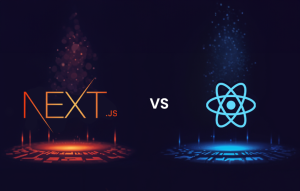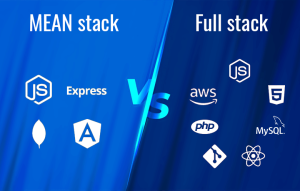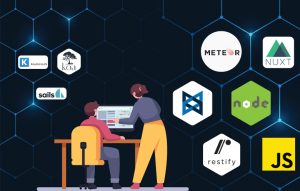As the name indicates, full stack developers cater the complete project from designing the concepts, developing the solution and deploying it properly. Full stack development includes both; the front-end and the back-end development along with the creation of the database. And you need all these to develop your solutions. When you opt for full stack development, you get to choose a developer or a team of vetted developers to work on your project, depending upon your requirements.
When thinking about developing applications and websites, you must try to leverage the expertise of a full stack development service provider and qualified software developers. By outsourcing or hiring remote developers, you can get the benefit of adept knowledge and experience from the variety of web sources a full-stack web developer has access to. Whether creating apps or websites, you can leverage this know-how by hiring a qualified software developer.
Hire full-stack web developers to perform both front-end and back-end development tasks. They are flexible and offer expertise in specialized areas your business needs for further development.
We can categorize the entire full stack development in three stages, namely; the front-end, the back-end and the database.
The front-end focuses on the client-side development of the solution, i.e., the User Interface. It consists of the complete user-facing sections of software development. Front-end developers implement visual elements and take care of how the solution will appear, interact and operate with end-users.
The front-end is the visible part of the website that reflects user experience and is developed using front-end languages such as HTML (Hypertext Markup Language), CSS (Cascading Style Sheets) and JavaScript. Front-end developers create the code that uses JavaScript, HTML and CSS to control the interactivity and the appearance of a site in the browser.
The back-end is known as the server-side layer of the application. It is responsible for the solution to function appropriately. Back-end developers when designing web and mobile projects use programming languages such as Java, Python, Node.js, PHP, C#, etc. Back-end developers create and work with databases.
The database is also one of the important aspects of back-end programming and full stack developers develop and maintain it.
Therefore, full stack developers are experts in both technical domains. They are well-trained to work on front-end, back-end, database queries and different operating systems.
The advantages of hiring full stack developers:
1. Skillful developers
Full-stack developers have the knowledge, skills and expertise to add cutting-edge features to your solutions. The experts possess experience in managing the whole stack from the ground level. And this is exactly what you need to achieve great returns from your project. Not just this, full stack developers also have the proficiency to handle your project on the whole.
2. Flexibility
When you hire full-stack developers, you get professionals who are skilled in both front-end and back-end development. Back-end developers write prototype codes to connect your solutions to other CMS. And the front-end developers create code to manage how it appears and interacts with a browser. A full stack developer is capable of doing both of these tasks. The developers are dedicated, goal-oriented and work continuously towards meeting the customer expectations to deliver the best solutions in the industry.
3. Enormous experience
Full stack developers work in both the technical domains: front-end and back-end. This is because they have in-depth knowledge and immense experience in the field of web and app development. This is one of the main reasons why it is always better to hire a full stack developer to build your projects. You can utilize both their insights and experience, which is definite to prove beneficial for the performance of your project in the long run.
4. The add-ons
A full stack developer can help with the entire design structure. They can provide their input at any level that you would require. They excel above web and app development to sustain and optimize existing systems. They are well versed in switching between side-end and Minimum Viable Product (MVP) development and they are well aware of how to approach code design.
5. Up to date
Projections illustrate that global e-commerce sales would grow to $6.4 trillion by 2024. So, you can imagine how many people are using the World Wide Web to browse, purchase products and avail the required services. And these numbers are increasing every day.
In a recent study, more than 90% of people confirmed that the main reason for choosing or rejecting a website or an app is its design. Again, full stack developers come into the picture since they have the expertise in building these solutions for years.
They make your web or app project more user-friendly. And due to the dynamic nature of the job, they are always up to date with all the latest technological advancements.
There will be 27.7 million developers operating by 2023.
Evan Data Group
MERN, MEAN, and LAMP
MERN, MEAN and LAMP are popular technology stacks used for web development. Here’s a brief overview of each:
MERN Stack:
Components: MERN stands for MongoDB (database), Express.js (backend framework), React (frontend library) and Node.js (runtime environment).
Key features: MERN is known for its full-stack JavaScript capabilities, making it seamless for developers to work with a single language throughout the development process.
Use cases: MERN is well-suited for building dynamic and interactive web applications, particularly those requiring real-time updates and a responsive user interface.
MEAN Stack:
Components: MEAN stands for MongoDB (database), Express.js (backend framework), Angular (frontend framework) and Node.js (runtime environment).
Key features: Like MERN, MEAN also uses JavaScript throughout the stack. Angular is a robust frontend framework that offers two-way data binding and is suitable for building complex web applications.
Use cases: MEAN is a versatile stack often used for developing large-scale, data-driven applications where Angular’s features are beneficial.
LAMP Stack:
Components: LAMP stands for Linux (operating system), Apache (web server), MySQL (database) and PHP (programming language).
Key features: LAMP has been a longstanding choice for web development, offering stability and a wide range of open-source tools. It uses PHP as the server-side scripting language.
Use cases: LAMP is well-established and commonly used for building various types of web applications, particularly content management systems (e.g., WordPress) and web portals.
These technology stacks cater to different development preferences and project requirements. MERN and MEAN are known for their flexibility and modern JavaScript-based approach, while LAMP has a history of reliability and is still widely used, especially in legacy systems and shared hosting environments. The choice between them depends on factors like project complexity, developer expertise, and specific application needs.
Hiring models
There are several engagement models that you get to choose from when you hire a full stack developer for building your solutions:
1. Offshore support model
When you choose this model, the developers remotely connect with you to resolve your issues. Software like GoToAssist, LogMeIn, VNC, or TeamViewer are leveraged to enable secure control over the team.
2. On-site support model
By choosing this model, you get continuous support from developers when you need:
- On-premises technical assistance
- To modify any existing system
- To migrate from a legacy system
3. Hybrid model
A hybrid model is ideal for you if you are starting any complex or long-term IT project. Full stack developers help you with service delivery amid local systems, centralized shared services and the external outsourcing of service delivery.
4. Support time & material (T&M)
This model provides you with the flexibility to work with developers and pay only the actual cost of direct labor. The cost is based on an hourly basis, materials and equipment used. You can expect a quick start, better efficiency, flexibility and control over each development stage.
Process of hiring dedicated developers:
As industry leaders with over two decades of experience, we guide companies on how to hire full-stack developers. Our expertise is based on our deep understanding of the full-stack development landscape and the skills and experience that are essential for success. We can help you to identify the right full-stack developer for your needs and to create a hiring process that is effective and efficient.
Hiring dedicated developers involves a process of recruiting skilled professionals who work exclusively on your project, typically on a long-term basis. Here’s a brief overview of the process:
Define project requirements – Define scope, goals and tech requirements. Then, determine skills and expertise for development team.
Create a job description – Prepare detailed job description outlining roles, responsibilities and qualifications. Specify tech, exp. level and project duration.
Select a hiring mode – Offshore support model, on-site support model, hybrid model or support T&M. Dedicated developers can be hired through any of these models.
Screening and shortlisting – Shortlist candidates based on resumes and portfolios. Interview shortlisted candidates to assess technical skills, experience and cultural fit.
Technical evaluation – Evaluate programming skills with technical assessments or coding tests, based on project needs.
Interviews – Conduct in-depth interviews to assess problem-solving, communication and alignment.
Reference checks – Verify work history and performance with references.
Offer and onboarding – Extend offers to the selected developers and facilitate onboarding by providing access to project resources, tools, and documentation. Ensure they understand project objectives and requirements.
Performance evaluation – Evaluate performance and provide feedback for skill development.
While hiring dedicated developers ensure you have the right talent working on your project and that they align with your project’s goals and culture. Effective communication and ongoing management are crucial for the success of the engagement.
Hire full stack developers now!
Full stack developers are well aware of trending technologies and other innovations. They are familiar with all aspects of websites and web and mobile applications. They are also knowledgeable about the problems that can arise during the pre-development and post-development stages of your project. Based on the advantages that you get when you hire full stack programmers, it can be said that they fit your requirements very well, especially if you need fast project execution and high-quality solutions.
Full stack developers can work with different types of software tools, create unique code and help run websites and other functions. To know more about how full stack developers can help you with the development of your front-end and back-end projects, talk to our experts.








